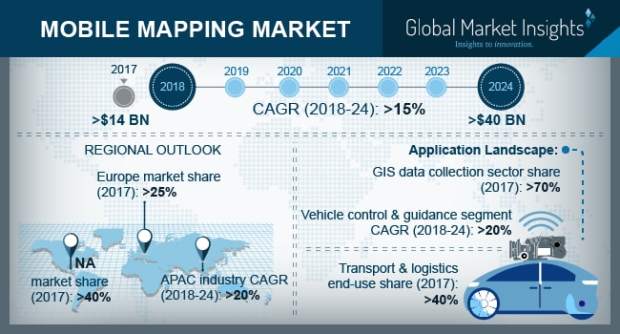
The size of the mobile mapping market was estimated at $14 billion in the year 2020 and is predicted to reach $40 billion by 2024, rising with a CAGR of 15% between the years 2020 to 2024, according to research by Global Market Insights, Inc.
The market is driven by the increasing adoption of smartphones and other mobile devices. The traditional mobile mapping systems are expensive due to the need for expensive sensor components. The advent of mobile devices equipped with remote sensing and positioning capabilities allowed the users to use the mapping applications for navigational purposes. Over the past decade, there has been a significant increase in the number of mobile phone users using navigational applications to get instant driving directions. Many users are also using the mapping services for non-driving directions such as walking, public transportation, and cycling. This has encouraged mapping companies to acquire GIS data maps for various location-based services across the globe to enhance the customer experience.
However, the data accuracy concerns associated with mobile mapping technology are hindering market growth. The primary basis of classification & abstraction in most of the GIS applications is based on the real-world phenomenon. In most of these applications, users have the option of deciding the amount of information to be used and their classification into multiple categories. Nevertheless, users sometimes reduce the accuracy of the mobile applications by misclassifying the information into inappropriate categories.
The hardware sector is leading the mobile mapping market landscape with over 60% share. The market is driven by growing demand for laser ranging and scanning devices across the globe. The laser ranging and scanning devices market is estimated to grow at a CAGR of over 15% over the projected time frame. This growth can be attributed to the growing adoption of laser scanners as they are easy to operate across demanding environments. Positioning devices are also estimated to grow at a rapid pace due to their widespread adoption among the automotive sector for navigation and driving assistance purposes.
The software market is expected to grow at a CAGR of over 15% between 2018 and 2024. The software market includes data extraction and data processing applications. The data processing applications are used to store the data received through the GPS, IMU, and laser scanners into a single integrated database and combine spatial data with various measurements and attributes. The services market is anticipated to register a growth rate of over 15% over the projected time period. This can be attributed to its growing awareness of mobile mapping technology in several verticals such as BFSI, retail, and logistics.
Mobile mapping technology is used across various sectors for collecting the GIS data. It accounts for over 70% of the total market revenue. The mapping solution providers, such as Apple, Google, and TomTom, are leveraging mobile mapping technology to collect georeferenced data and increase the precision of their maps. The vehicle control & guidance market is projected to grow at a CAGR of over 20% over the forecast period. This growth can be attributed to the growing demand for autonomous driving systems as they enable vehicles to map their surroundings in real time.
North America dominates the mobile mapping market with more than 40% in 2017. This growth can be attributed to the widespread adoption of GNSS, GPS, and LiDAR technologies across various industry verticals to collect geospatial data. In addition, the presence of major technology players such as Apple, Google & Microsoft in the region has further nurtured the market growth. The availability of low-cost sensors and GPS-equipped mobile devices is expected to foster the market.
The mobile mapping market has displayed rapid growth over the past three to five years as the players operating in the market have attracted investments to capitalise and commercialise the technology. The players in the market are entering into strategic partnerships with other companies to increase their market share. For instance in 2018, PhaseOne industrial partnered with Aerialtronics DV, a developer of end-to-end aerial data capture. This partnership is aimed at mitigating the risks associated with aerial data acquisition and pooling their resources together to develop new products. Similarly in 2016, Hexagon acquired SCCS, a leading supplier of Leica Geosystems surveying equipment in the UK. This will enable Hexagon to capitalise on growing opportunities in the UK.
The major companies in the mobile mapping market are Hexagon, Foursquare Labs, Mapquest, Mitsubishi, NovAtel, PhaseOne Industrial, Sharp Corporation, TomTom International, Topcon Positioning Systems, Teledyne, Optech, Phoenix LiDAR, NCTech, Microsoft, Navteq, MapJack, and EveryScape.












